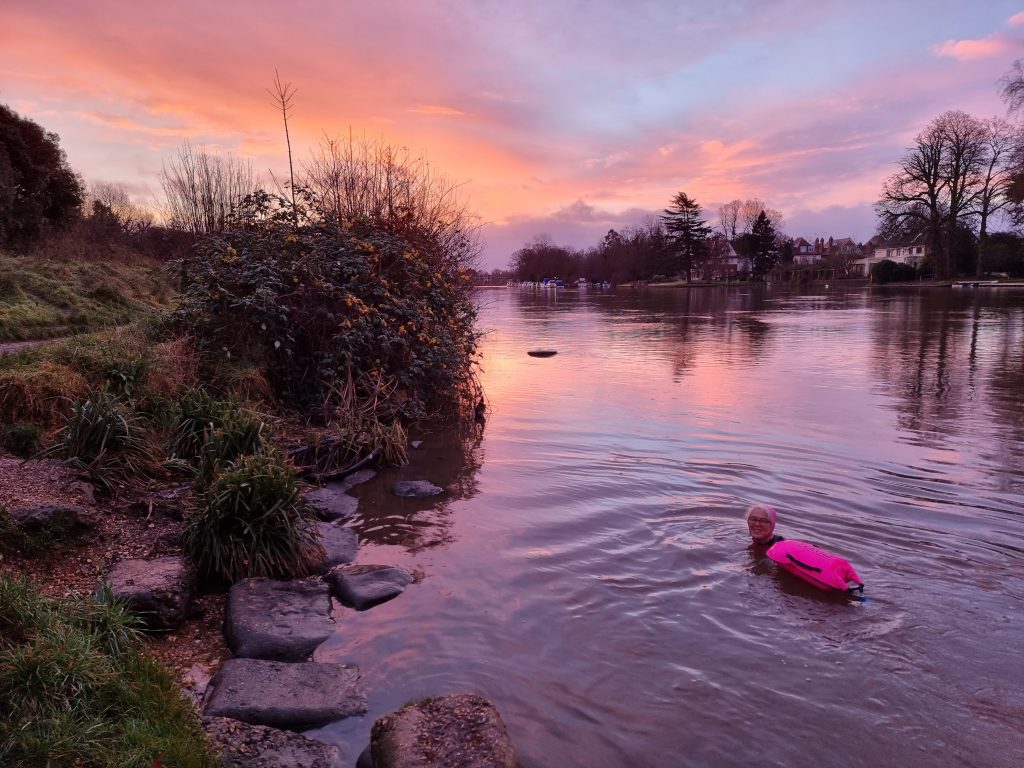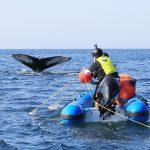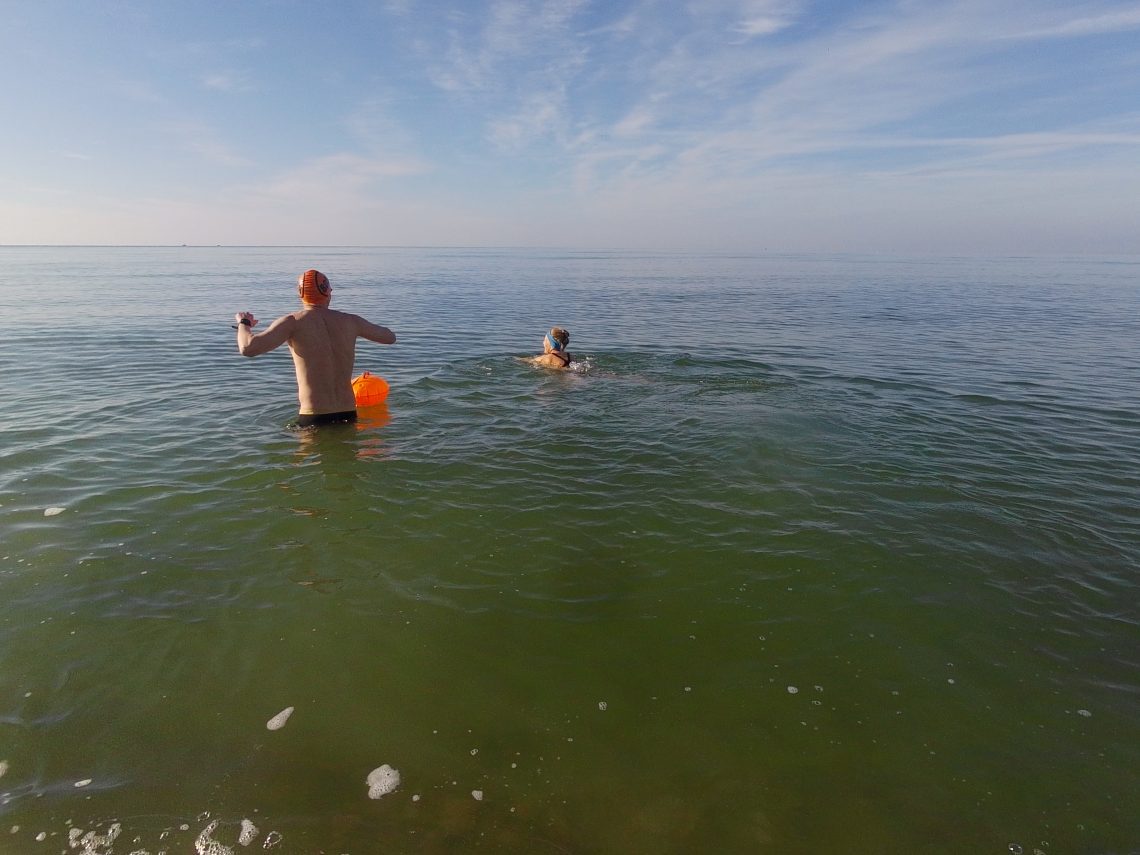
Trends in Outdoor Swimming 2023
What’s happening in the world of outdoor swimming? Who is swimming where and when? And what do swimmers care about?
Welcome to our latest Trends in Outdoor Swimming update, our annual review of what’s happening in outdoor swimming. Our aim, as usual, is to share our understanding of trends and changes to help you with your planning and decision-making.
The last time we published, we were emerging from the Covid pandemic and were optimistic about 2022. We didn’t foresee war in Ukraine, spiking energy prices and the cost of living crisis. The ripples from those events have impacted outdoor swimming more than you might expect, given that it is, in essence, a free activity.
But, as we will see, almost one-third of outdoor swimmers who completed our Attitudes to Outdoor Swimming survey say their swimming has been affected. More positively, although we didn’t ask for this, others told us that their appreciation of being able to swim outdoors has increased this year.
Furthermore, around 14% of survey respondents started in the previous 12 months, showing that growth has continued despite the economic slowdown. At the same time, 42% of swimmers have been doing it for more than 4 years, since before the Covid pandemic, suggesting that outdoor swimming is not the fad that some newspaper columnists would have us believe.
The most popular outdoor swimming activity is ‘wild swimming or dipping in summer’, with 84% of respondents saying this is an activity they’re interested in doing. This was closely followed by ‘wild swimming or dipping in winter’, which 75% of people in our survey are interested in. Both of these far outstripped the desire for ‘recreational or fitness swimming in a pool’, which only was of interest to 51%. This is a decrease in interest in pool swimming from what we’ve seen in previous years.
The most popular time of year for outdoor swimming is summer, followed by autumn. Winter was the least popular time of year to swim but it’s not unpopular: 65% of people said of winter swimming ‘I love it. I get a real buzz from it and do it as often as I can.’ But people do change their swimming habits in winter. Half of people said they switched to fun dipping outside rather than trying to swim long distances. Meanwhile, 36% of people do more indoor swimming while fewer than 2% stop swimming completely.
The most common motivation cited for outdoor swimming is for mental health and general wellbeing, which was the first choice of one-third of respondents. A further 22% voted that reason as their second choice (out of six options). The next most popular was for physical health and fitness, which was the first choice of just under one-fifth of people and the second most important reason for 26% of people.
Sewage pollution and water quality is seen as the biggest barrier to continued growth in outdoor swimming, with 41% of people ranking it highest. Access to water, legal restrictions or overbearing health and safety culture was seen as the second biggest barrier.
Regarding planned swimming activities over the next year, 80% definitely want to wild swim in their own country, and 52% definitely want to swim at a supervised venue. Just under a third of people say they definitely want to wild swim in another country with a further 32% saying it’s quite likely that they would.
Finally, growth in outdoor swimming continues to be driven by women, who made up 77% of our survey sample, up from 73% last year. A quarter of respondents are age 40 to 49, just over a third are 50 to 59 and a fifth are in their 60s.
I hope the above gives you a taste of what’s in this year’s report. Outdoor swimming is a fabulous activity that’s become increasingly important in people’s lives over the past few years, and also a force for the good in highlighting water quality issues and pushing for change. We’re proud to be part of this vibrant community and are, as ever, grateful for all the support and encouragement we receive.
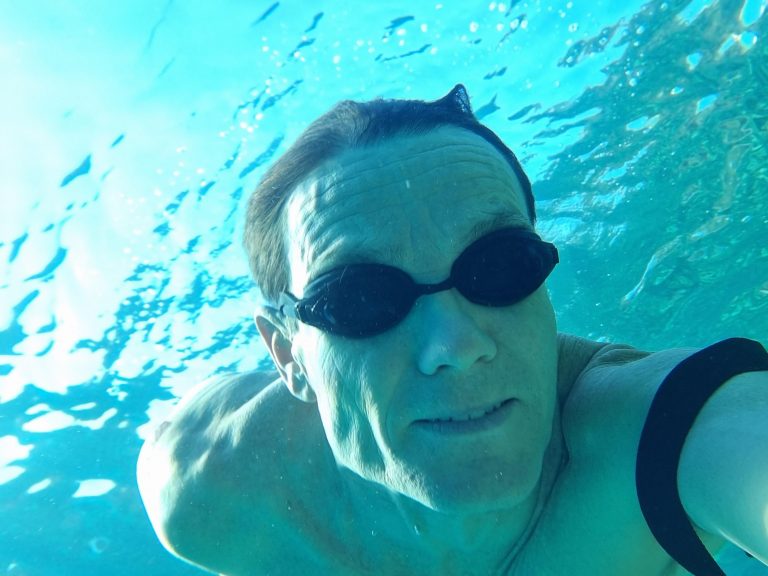
If you’d like to discuss outdoor swimming in more detail or for more marketing insights and ideas, please get in touch.
Simon Griffiths
Founder and publisher, Outdoor Swimmer magazine
p.s. Many thanks to STA for sponsoring this year’s Trends in Outdoor Swimming update
Trends in Outdoor Swimming 2023: Contents
Is outdoor swimming still growing?
Why did you start outdoor swimming?
What types of swimming are you interested in doing?
What swimming activities have you planned for 2023?
How has the cost of living crisis impacted outdoor swimming?
What are the barriers to continued growth in outdoor swimming?
What kit are you planning to buy in 2023?
Which are the top 10 most recognised brands in outdoor swimming?
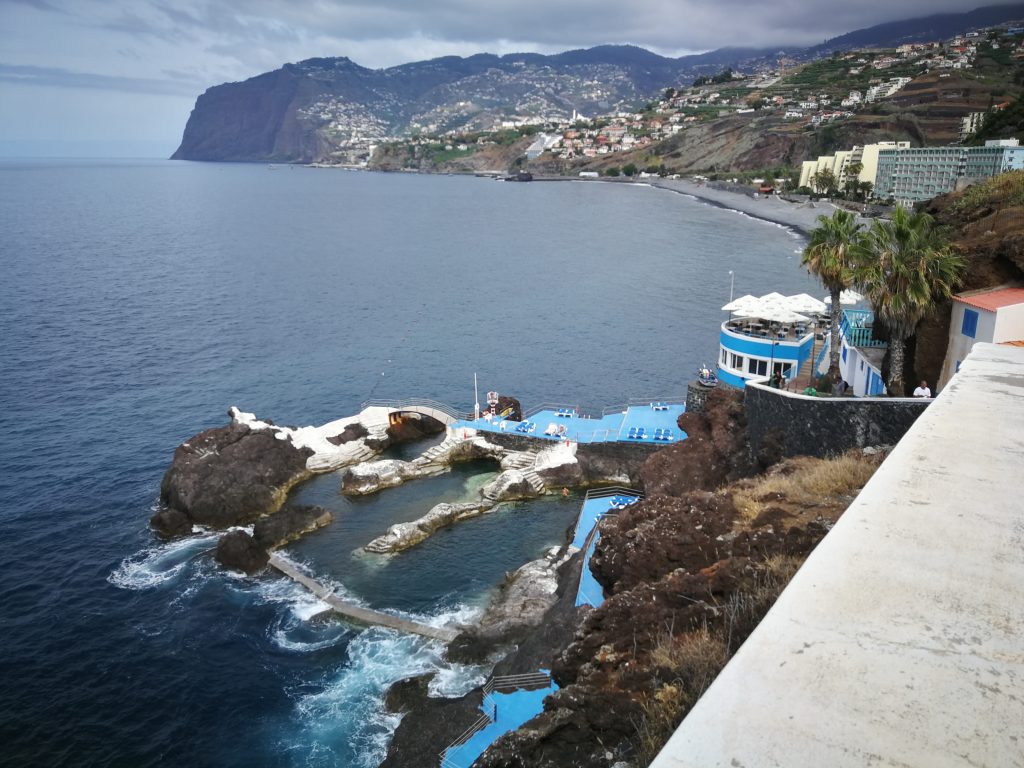
Is outdoor swimming still growing?
Outdoor swimmers are notoriously difficult to count. Very few are formal members of clubs whose numbers might be counted by Swim England, the National Governing Body for swimming. Membership numbers of Facebook groups suggest an interest in outdoor swimming rather than active participation. My local Bluetits group, for example, has nearly 1,000 members, all signed up over the past two years. But of those, typically only between 20 and 50 turn up for their regular Saturday morning dip. It’s a similar story with swimming groups around the world. Still, it says something positive about outdoor swimming if a thousand people think they want to swim in the Thames.
Data from Sport England’s Active Lives Survey paint a confusing picture. The most recent results are for the period November 2020 to November 2021. They estimate 408,000 people participated in open water swimming at least twice in the previous 28 days (when they were asked), and this was an 18% increase from 344,800 in the year before.
In contrast, when they asked about participation in the previous year, only 2,677,000 said they had, down from 3,766,500 the year before – a drop of 29%. It’s difficult to interpret this discrepancy, but one explanation could be that fewer people are trying outdoor swimming, but more people are doing it regularly.
Still, the annual decline puzzles us. It seems at odds with anecdotal evidence and the amount of mainstream media coverage of outdoor swimming. For example, the search tool at english-corpora.org shows the use of the term ‘wild swimming’ in internet news stories has jumped from 72 occurrences in 2019 to 447 in 2022. If we look at Google’s data for the number of people searching for the term ‘outdoor swimming’, we see it peaks in 2021, but the number is just 3% lower in 2022.
Occurrence of the term “wild swimming” by year in internet news articles
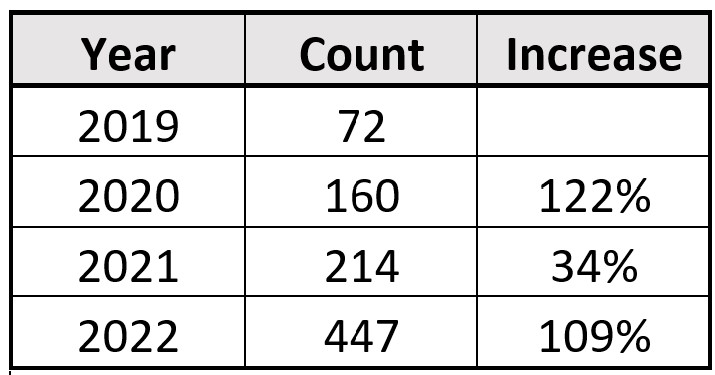
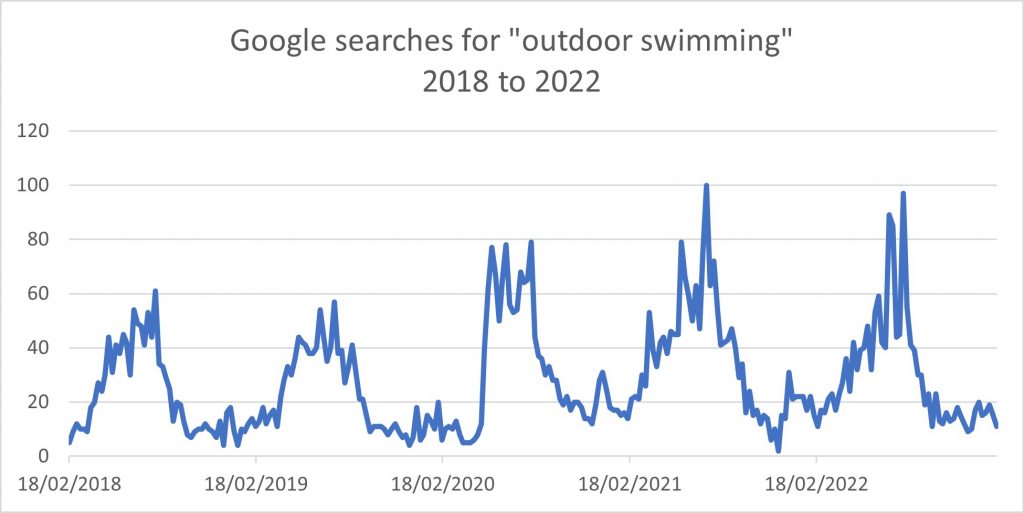
Another explanation for the inconclusive numbers from Active Lives could lie in definitions. The Survey asks about “open water swimming”, which some people associate with racing or triathlon-type swimming. It’s possible that recreational outdoor swimmers don’t classify the swimming they do as ‘open water swimming’.
In our Attitudes to Outdoor Swimming survey, we don’t try to count overall numbers, but we do ask people when they started, which gives us a sense of growth rates.
Overall, 14% of our survey respondents stated that they started outdoor swimming in the previous 12 months – i.e. sometime in 2022. This is a decrease from the 18% we recorded in 2021, when lockdowns and restricted pool access were pushing people outside, and suggests that growth has continued, although at a slower rate.
While our survey gives us an idea of how many people are taking up outdoor swimming, we can’t measure the number who give up. We know that some people move away from swimming because of changing interests, ill health or relocation. And anecdotally, as we will see later, we know others are put off by worries about pollution. We also know that the cost of living crisis has curtailed some swimming activities.
Nevertheless, our data also show that once people discover swimming, they stick with it for a long time. Almost 1 in 5 started between 2 and 4 years ago, while 42% have done it for more than 4 years. Around 17% started between 1 and 2 years ago – during the pandemic and its immediate aftermath.
Diving deeper into the data, we see the growth is mainly driven by women. We again saw an increase in the number of women responding to our survey. They now make up 77% of respondents, up from 73% last year and 55% when we first started collecting data before the pandemic. Of those women, 18% started in the previous 12 months. In contrast, only 12% of men did.
Interestingly, while more women than men in total started during the two years of the pandemic, out of men who currently swim outdoors, more than half started more than 4 years ago, compared to 39% of women.
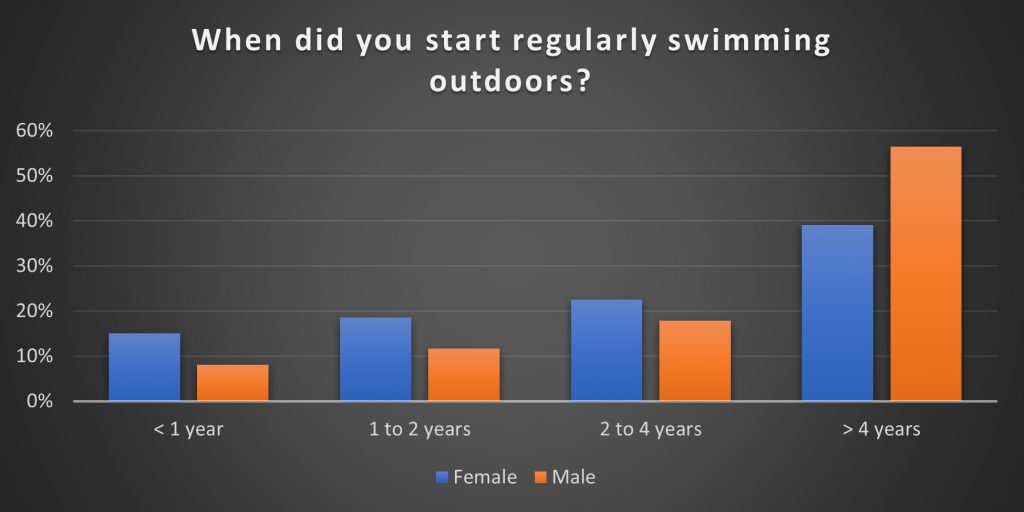
Overall, we conclude outdoor swimming is still growing but concerns about pollution and personal finances have dampened the growth rate compared with 1 to 2 years ago. We will explore some of the barriers to growth in later chapters. Next, we look at why people started.
Why did you start outdoor swimming?
Given the large number of people who started outdoor swimming during the time of the pandemic, we were surprised that only 9% of our survey respondents said they started ‘when pools were closed for Covid’. In fact, it was the least common reason men gave for starting outdoor swimming, and the second least for women. While many people started outdoor swimming during the pandemic, they didn’t start because of the pandemic.
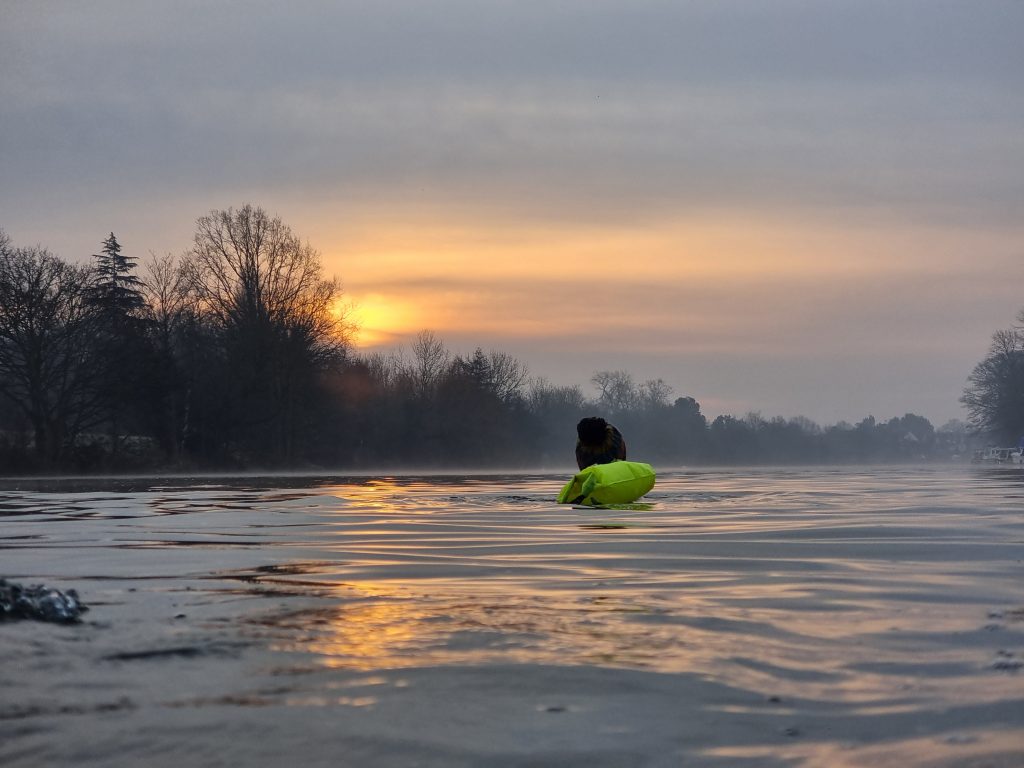
In a change from last year, the most common reason stated for starting among women was ‘for the mental health benefits’, which ranked fifth last year. For men, it was the third most common reason, up from seventh. Last year we noted a correlation between how long people had been swimming and the likelihood that they started for the mental health benefits: those who started most recently were more likely to state the mental health benefits as a motivation. It’s not surprising then that mental health has moved up the rankings.
The most common reason for starting outdoor swimming for men this year was for the physical health benefits, which ranked third for women. Men are also more likely to start because they entered a swimming event and, by a large margin, because they entered a triathlon.
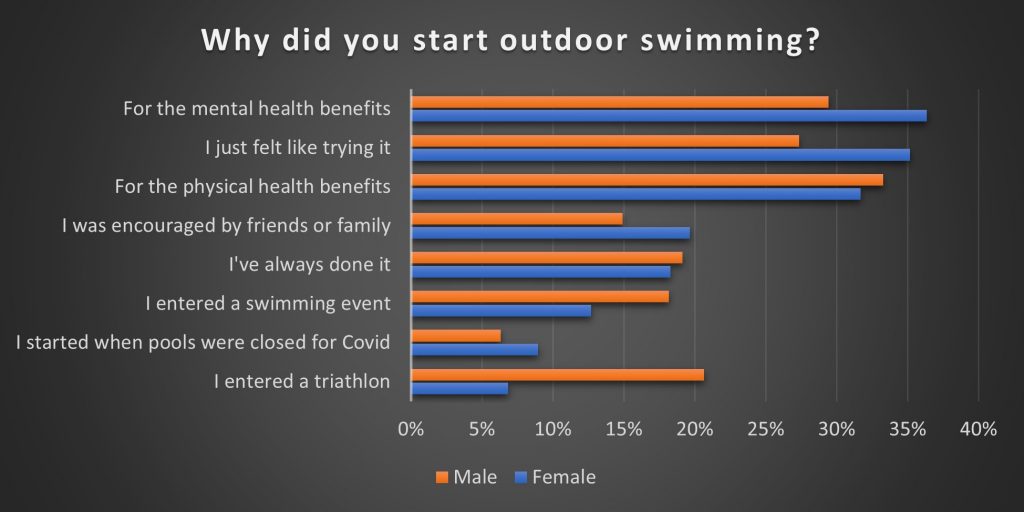
(Note: numbers add up to more than 100% because respondents could select multiple reasons)
Why do you swim outdoors?
In previous years, we’ve found that people’s motivations to swim outdoors differ from their reasons for starting. This year, we found the correlations were closer. Women ranked the mental health benefits of outdoor swimming top as their reason to start, and said their main motivation to continue was for ‘mental health and general wellbeing.’ For men, ‘the physical health benefits’ were the main reason to start and ‘physical health and fitness’ was the top reason to continue. Interestingly, while outdoor swimming groups tend to be sociable and community-orientated, both men and women ranked ‘to connect with other people’ bottom in the list of reasons for swimming outdoors.
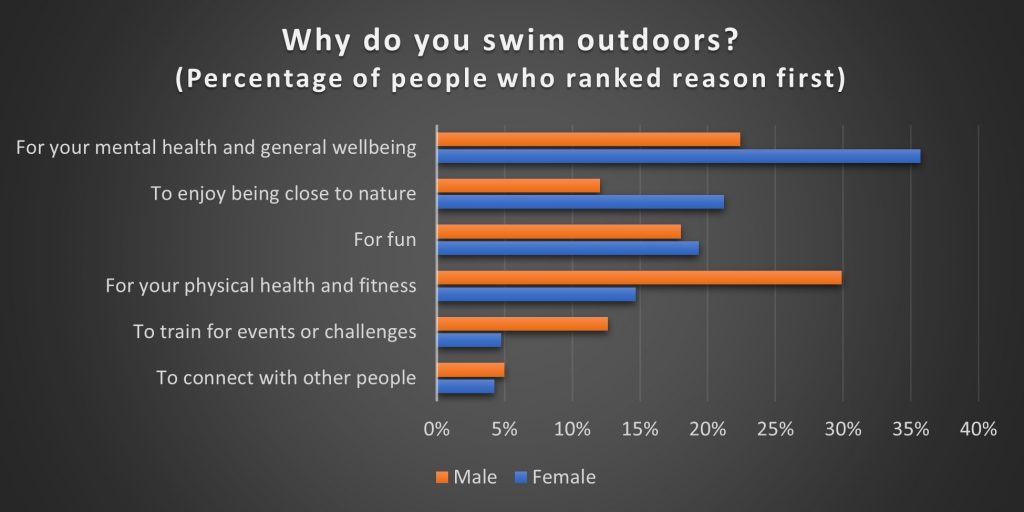
For this question, we also included a free field answer, and nearly half of respondents left an additional answer, some at length and in detail. For example, one person describes an adverse response to a Covid vaccination that left them with little strength on one side, and how, with the support of friends, outdoor swimming became a sort of physiotherapy and massive help in their recovery. Here are a few more, to give a sense of the range.
- It’s free, there’s plenty of room for everyone and no time limits. (The theme of it being free was repeated often.)
- Because I live at the seaside and it’s like I’ve been given this beautiful resource so I should make the most of it.
- Lovely time with my teenage daughter who also swims.
- Struggle in a pool due to PTSD.
- To escape other people.
- It soothes me and brings me strength.
- Because of the freedom you feel having no lanes or walls to restrict you. (The link with a sense of freedom was also frequently mentioned.)
- I seem driven to do it and I’m sometimes unsure where that comes from!
- To feel alive.
- I hate chlorine. I feel like I belong in the water.
- Love swimming, don’t much like swimming pools.
- It’s good for my soul. It’s my day of self-compassion.
- Sense of wellbeing and being at one with myself and nature.
- Pool swimming tends to be rushed, crowded and hierarchical.
We could go on. For those who do it, outdoor swimming makes an important difference in their lives. We also looked at which words in the full dataset appeared most frequently. Top words included love, freedom, challenge, amazing, buzz, nature, peace, outdoors and space.
What types of swimming are you interested in doing?
Not only do men and women differ in their motivations for starting outdoor swimming, but they also differ in the types of swimming they like to do – although there are plenty of commonalities too. Both, for example, like wild swimming or dipping in summer, which ranked as the top activity for women (with 87% saying it’s something they’re interested in doing) and second for men (74%). Swimming or dipping outdoors in winter is almost as popular among women as it is in summer, at 80%. However, only 56% of men say they like outdoor swimming in winter. While these discrepancies aren’t a surprise, and we know that winter swimming has increased in popularity, it’s noteworthy that for most female outdoor swimmers it is totally a year-round activity. Winter wild swimming is their second most popular swimming activity.
For men, recreational or fitness swimming outdoors is the most popular type of swimming, with 75% saying they’re interested in doing this. The percentage of women is similar (73%) but this ranked third.
Interestingly, the biggest gap between men and women was their reported interest in long-distance solo swims. While this is an area where women excel (e.g. Sarah Thomas, Chloë McCardel), men were twice as likely as women to say they were interested in long-distance solo swims.
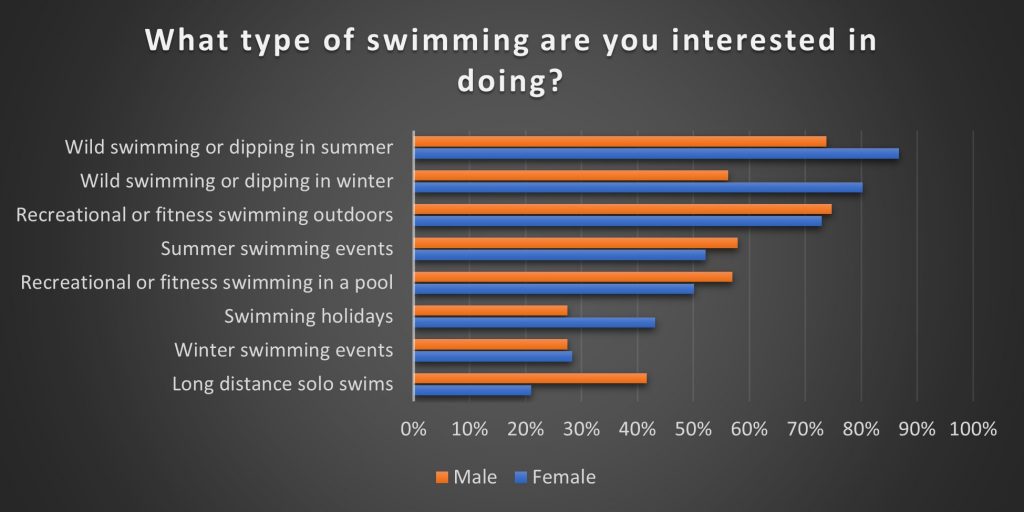
We note that interest in pool swimming is at 57% for men and 50% for women, which is a decrease from previous years, where we saw percentages in the 60s and 70s. Possible explanations are: new people coming into outdoor swimming are not pool swimmers; irritations with pool booking apps and number restrictions, which have been retained post Covid; and a desire to save money.
We next looked at seasonality in more detail, asking people to rate from 0 to 10 how much they liked outdoor swimming at different times of the year: zero for ‘not that much’ and 10 for ‘love it! ‘Favourite time of the year’. Again, we split the results by gender.
The first point to note is that 22% of women and 13% of men do not discriminate by season. Every time of year is their favourite for outdoor swimming. At the other end of the scale, a mere 6% of female swimmers rated winter swimming as zero, while 13% of men did. As we saw last year, women rate their enjoyment of outdoor swimming more than men at all times of the year, but the difference is most apparent in winter.
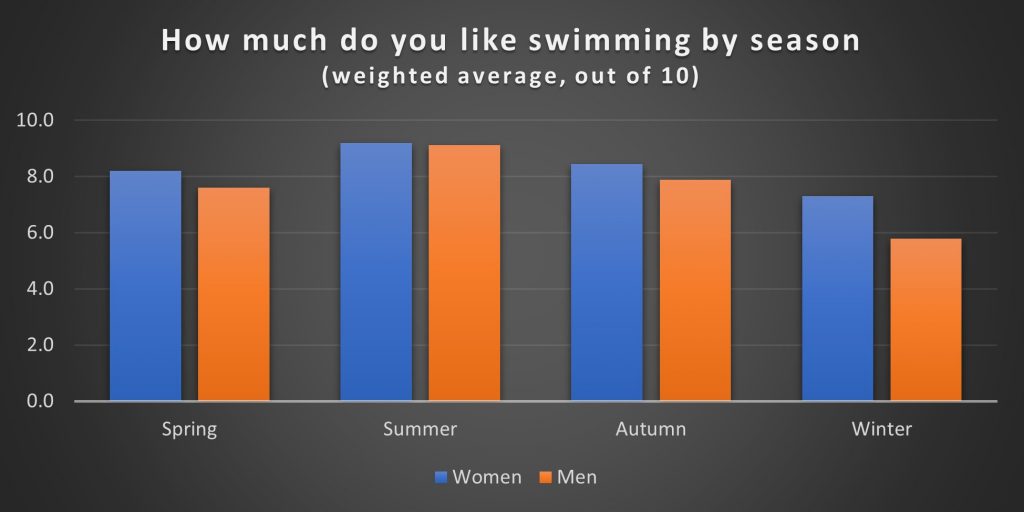
We then asked about the delights or otherwise of winter swimming, and again the gender split is dramatic.
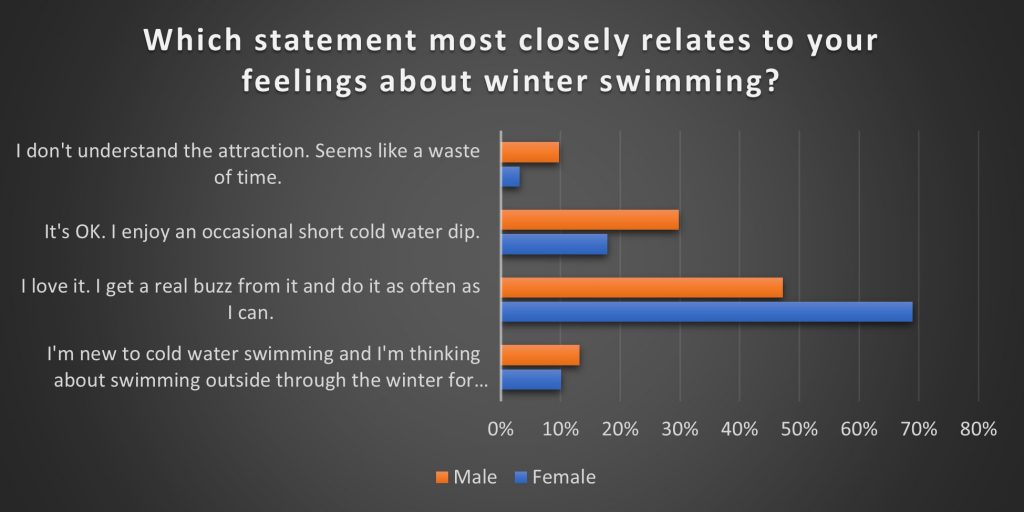
Winter swimming habits
Regardless of swimmers’ feelings about winter swimming, they need strategies to deal with colder months. You cannot simply carry on as you would in the summer. What we found is that swimmers adopt multiple approaches (an average of 1.5 strategies per person in fact). The good news is that very few (less than 2%) stop swimming completely.
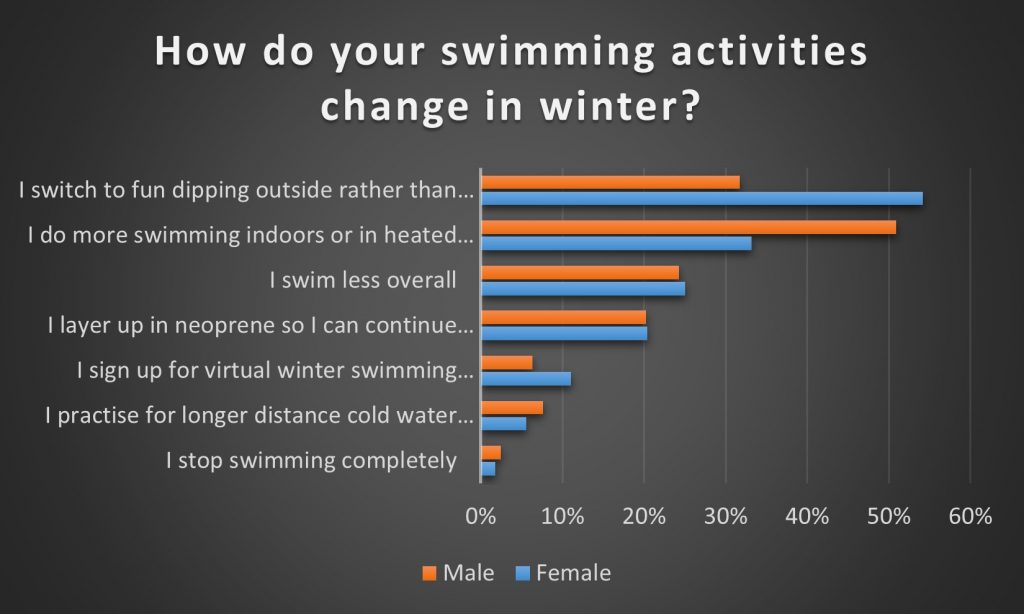
Winter swimming challenges
Finally in our review of winter swimming, we asked about interest in ‘ice’ swimming challenges of 1km and 1 mile in water of 5 degrees C or less – to be done in a standard swimming costume and without any neoprene accessories. Swimming either of these distances at those temperatures requires significant training and preparation, and needs to be done under supervision. Here’s the result.
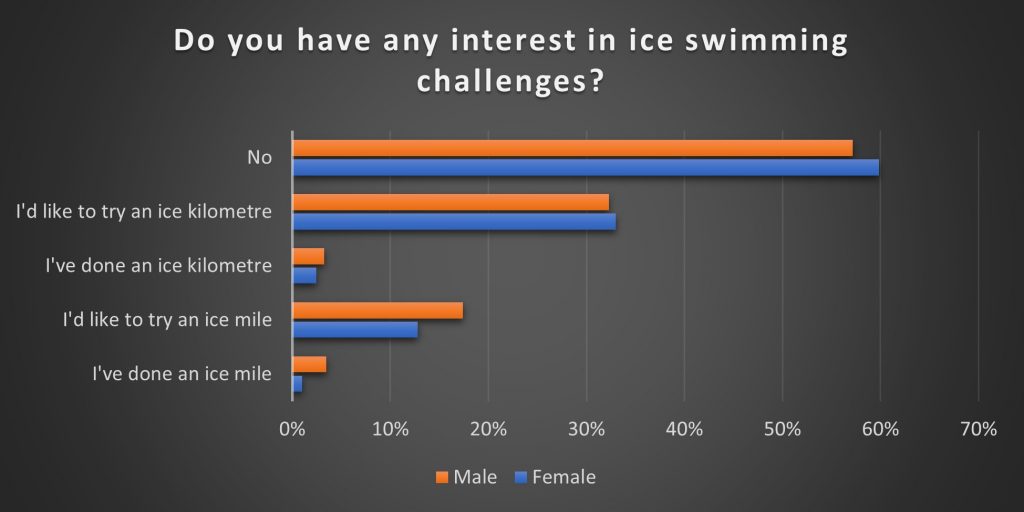
These are not insignificant numbers. Around 40% of outdoor swimmers say they want to test their limits in cold water. While this may present an opportunity for venues and event organisers, it’s also a risk. Compared to brief winter dips, ice swimming is an extreme sport that has the additional hazard of looking easy – until you’re helping someone recover from hypothermia.
If this is something you plan to do, or if you’re supervising someone training for or doing one of these challenges, please make sure you know what you’re doing.
Planned swimming activities for 2023
Doing a ‘wild swim in your own country’ is the most like activity for outdoor swimmers this year, with 76% saying they will definitely do it and a further 14% saying it’s quite likely. Fewer than 2% said it’s not something they will do. Swimming at a supervised venue, in contrast, only had 47% saying they definitely will, with a further 20% saying it was quite likely. We haven’t asked this question in this format previously, but comments made under our cost of living questions suggest some swimmers are planning to look for more free places to swim, or will swim at supervised venues less often than previously.
Another popular activity is wild swimming in another country, which 29% said they would definitely do, and 29% said was quite likely.
With outdoor swimming events, there was a noticeable gender split, with 43% of men saying they would definitely do one compared with 31% of women. Men were also twice as likely to say they will do a long-distance outdoor swim than women (21% compared with 11%). Note that these splits aren’t replicated at events because there are more women swimming in total.
Which of the following are you likely to do in 2023?

Swimming and the cost of living crisis
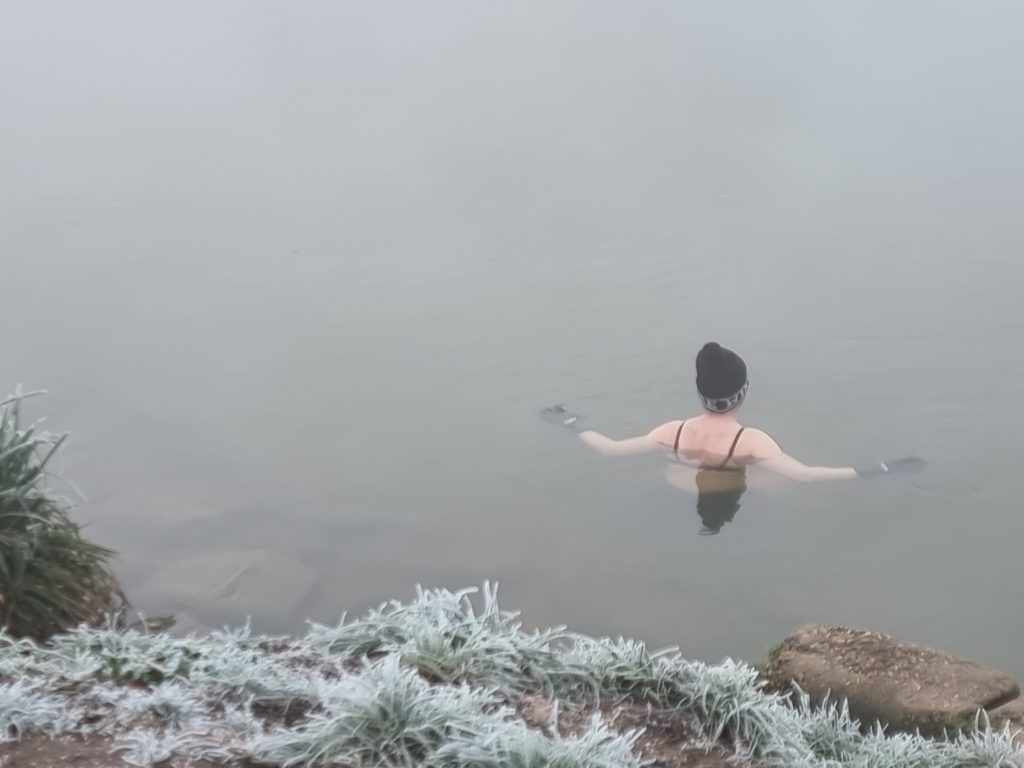
Despite the number of people who said one of the things they love about outdoor swimming is that it’s free, for a lot of others, it isn’t. Most swimmers will want to buy at least a costume before they start, and probably a few other bits and pieces too (we’ll look at what people are planning to buy in 2023 later). Then, if you live close to the sea, a river or a lake, you can swim free for a while. But not everyone is that lucky. They may need to spend on transport and parking costs before they can swim. Or they may prefer to swim at a commercial venue, where they have the reassurance of lifeguards and regular water quality checks.
Besides, we asked about swimming in general, not just outdoor swimming, and know more than half of outdoor swimmers also like to use pools, and that number increases in the winter.
The headline figure that falls out of our question about the cost of living crisis – that 70% say it hasn’t really had any effect on their swimming – is misleadingly reassuring. Turn it around the other way and we see that 30% – or almost one swimmer in three – has had their swimming impacted. Swimmers have cancelled their gym memberships, reduced pool swims, postponed holidays, delayed event entries and put off kit purchases. Some people have done all of these things.
More than 45% of respondents left us additional comments on this topic – far more than we can share here – but here are a few.
- I’ve held off on buying kit and tried to improvise or make do with what I already have. As much as I dislike the pool, I’d go more often if I could justify the cost, and I’ve put off trying a nearby outdoor venue, again because of the cost.
- The crisis has impacted my swimming in every way; from the ability to purchase and replace kit, sustain a beneficial diet, afford travel costs to and from venues and the weekly cost of the activity to the cost of laundering kit every week. With swimming being my only remaining social and fitness activity, I consider it to be absolutely vital to not just my physical health, but the only remaining pillar in my mental and emotional survival.
- The distance I travel to swim has had to reduce due to cost, therefore I can swim less often in the sea than I used to. (This is a common theme.)
- It’s made swimming less attractive, because of returning to a cold house. (Several people said something similar.)
- Using more of my free time to work has reduced my water time.
- I know I can’t buy any new kit (another common theme). I am only entering one event next year and one in 2024.
- More likely to swim on my own as group events incur a charge.
- Swimming holidays will now be too expensive. l was hoping to go next year.
- I was going to start pool swimming but have not now.
- Less after-swim coffee and cake.
- As a coach, business has been quieter (several people mentioned their swim businesses had been affected).
While the majority of responses listed negative impacts, it’s worth pointing out that some people said the cost of living crisis had helped them appreciate outdoor swimming more because it was a low-cost activity that brought them a lot of benefits.
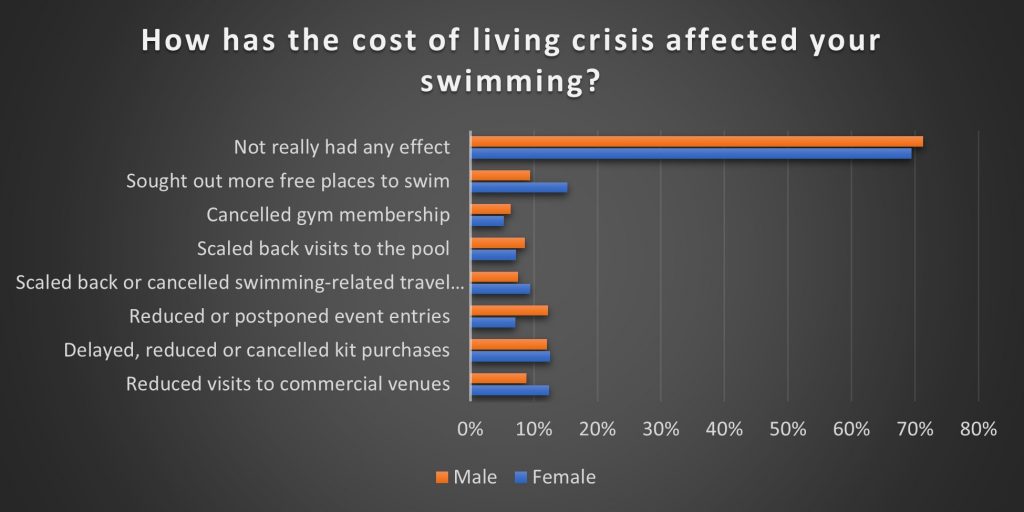
Barriers to continued growth in outdoor swimming
Several people used the space in the question on the cost of living crisis question to comment on other topics. In particular, sewage pollution. For example:
“Sewage pollution has stopped me swimming. I have been swimming outdoors since I was a toddler. My family all do. My children now do, my wife does, usually all year round. But sewage has stopped us. I feel very powerless and angry about it.”
Another person wondered if sewage pollution was linked to the cost of living crisis, with water companies allowing more pollution in order to save money.
We asked respondents to rank 10 potential barriers to continued growth in outdoor swimming. Sewage pollution and water quality concerns were the clear (no pun intended) ‘winner’: 41% of people ranked it as the biggest barrier and a further 20% ranked it second.
In second place, we had worries about access and legal restrictions, which were ranked as the biggest barrier by 18% of respondents.
Interestingly, despite the cost of living crisis, the three items on the list relating to money ranked lowest as potential barriers (cost of kit, entry costs at venues and entry fees to events).
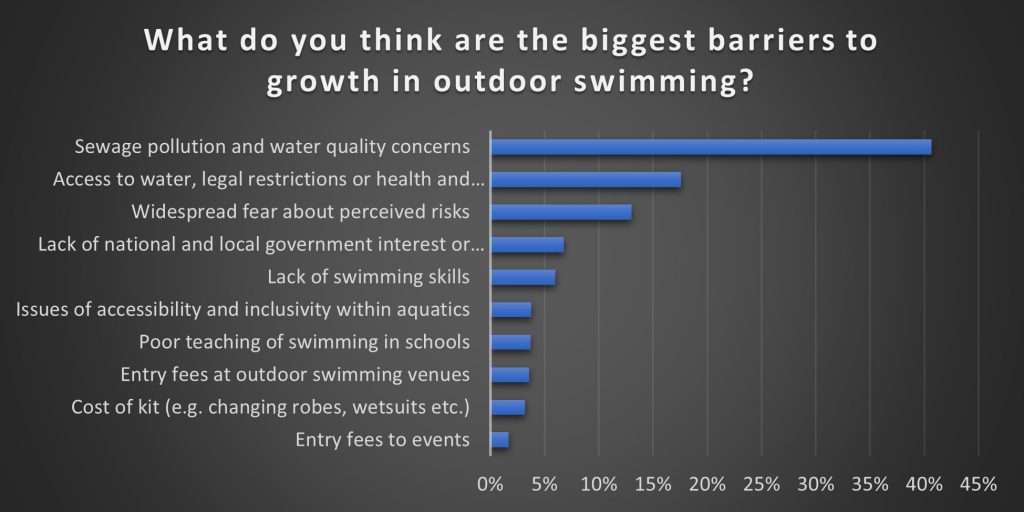
What will swimmers buy in 2023?
Can you go a full year without a shiny new swimming costume? It seems 10% of swimmers think they can. On the other hand, 35% said they will definitely get one and 43% said it was quite likely they would. The next most likely purchase is new goggles (24% definitely and 35% quite likely). After that, the next most sought-after item in 2023 looks like swimming-related books with 10% saying they would definitely buy one and 35% saying it was quite likely they would.
What kit are you planning to buy this year?

Top 10 most-recognised brands in outdoor swimming
We asked people to name three brands they associate with outdoor swimming, without giving any prompts or clues – just write down the first three brands you can think of. A total of 34 different brands were mentioned more than 10 times.
Top 10 brands recalled by outdoor swimmers, unprompted.
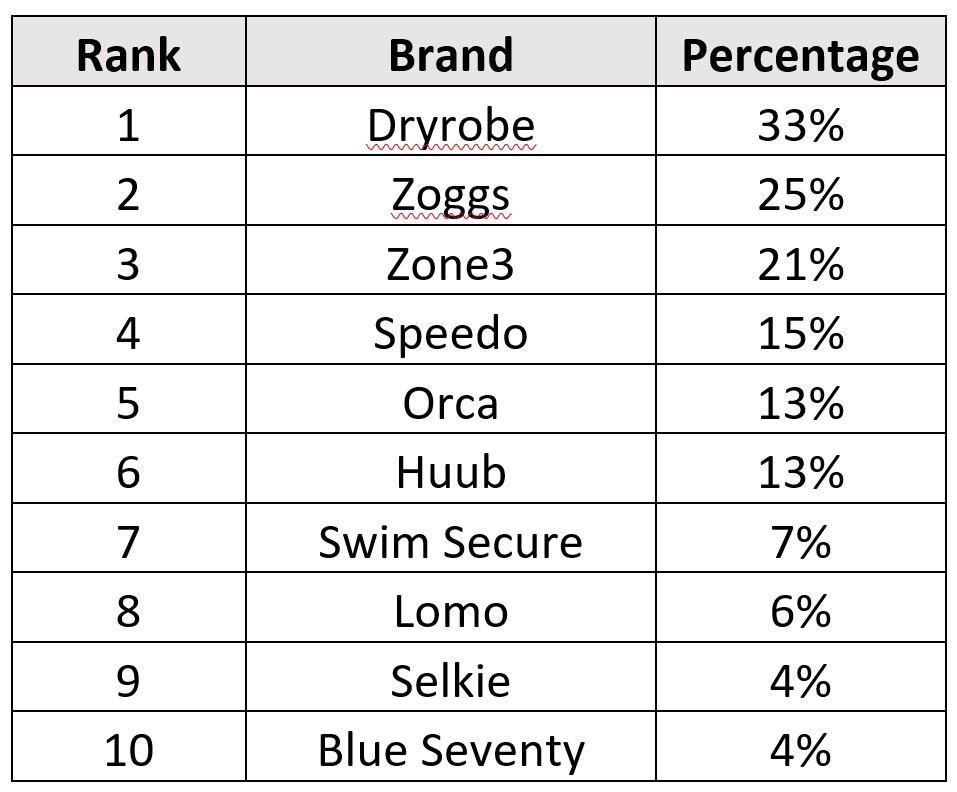
Demographics
Total responses: 2792
- Female: 2159
- Male: 523
- Prefer not to say: 17
- Non-binary: 5
- Prefer to self-describe: 1
Survey participants by age
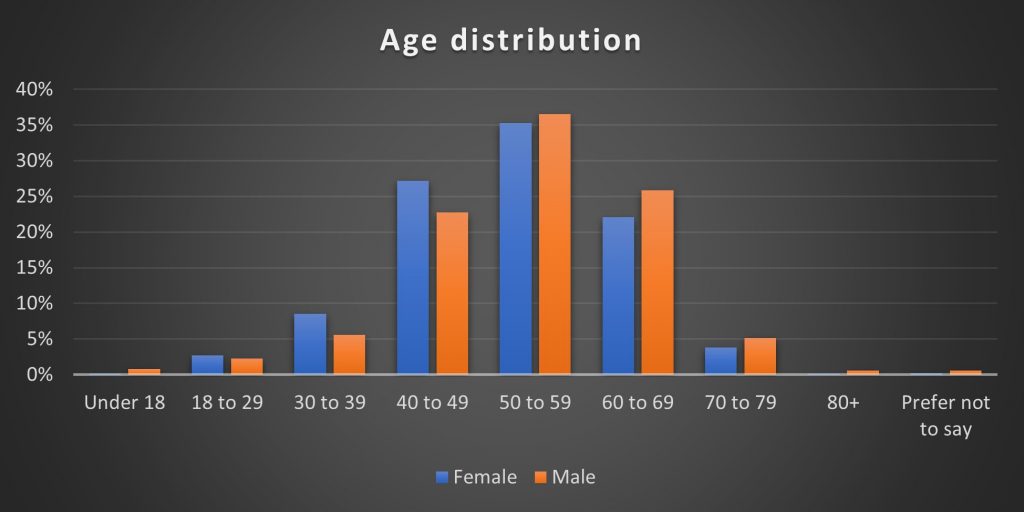
Geographic distribution
- England: 78%
- Scotland: 6%
- USA and Canada: 4%
- Wales: 4%
- Europe (excl RoI): 3%
- RoI: 2%
- Rest of world: 3%
Thank you!
Thanks are due to all our readers who gave up an average of 15 minutes of their time to complete our most recent Attitudes to Outdoor Swimming Survey. Second, we’re grateful to all the organisations who provided prizes to encourage people to complete the survey, and also for sharing the links to the survey through their social media channels. These were (in no particular order): SwimTrek, Orca, Swim Secure, Henley Swim, Huub, Vivida, South West Swim, Speedo, Chili Tri, Karen Parnell, Zoggs and the Big Retreat Festival. Finally, thanks to STA for sponsoring this report.
